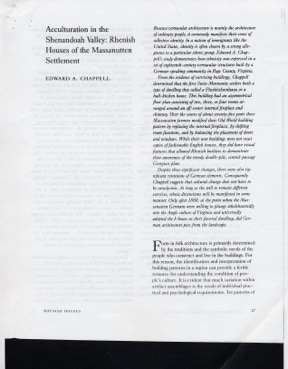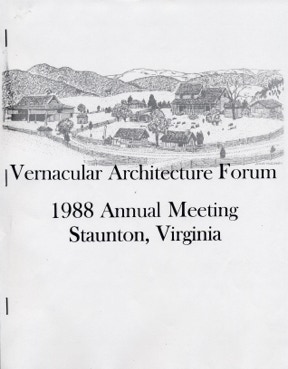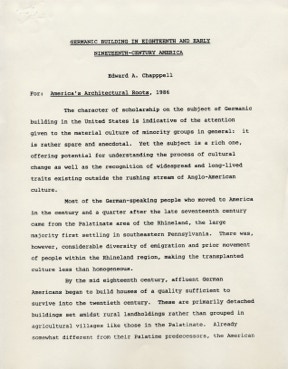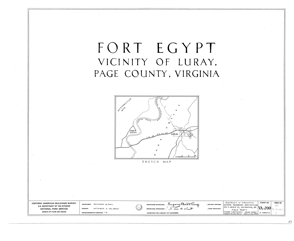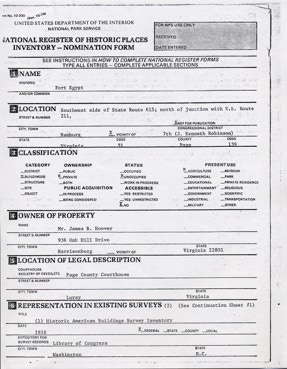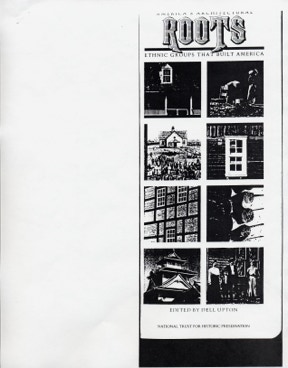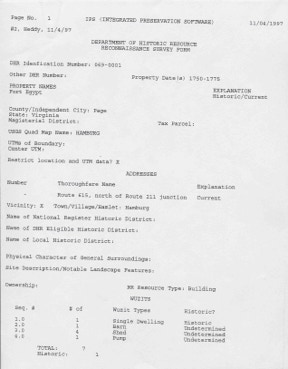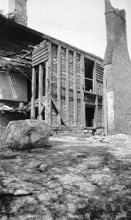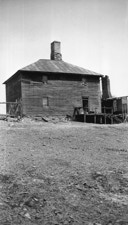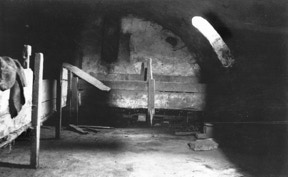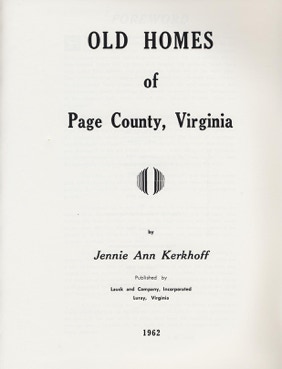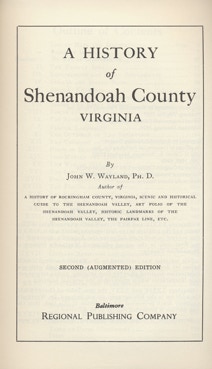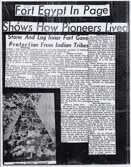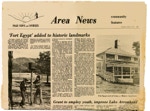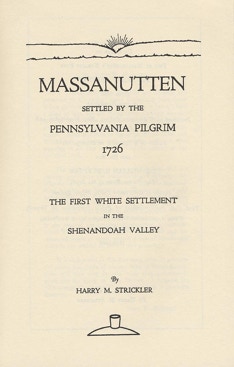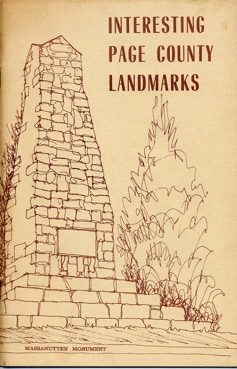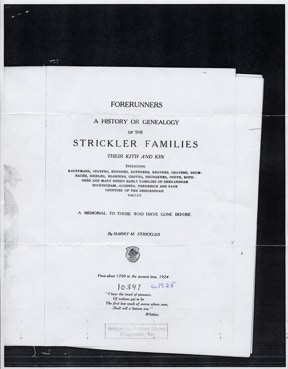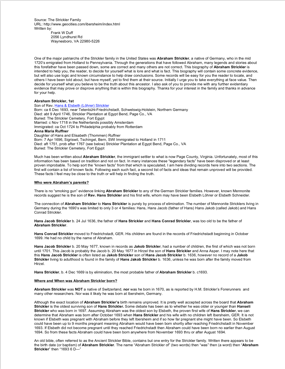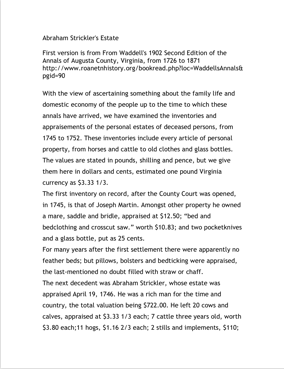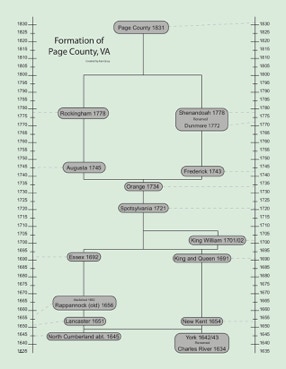Documents and Background Material
Fort Egypt is mentioned in a number of books, articles, surveys, and web sites. A collection of this reference material is listed below and can be viewed or downloaded. Much more information, especially genealogy related information about the Strickler family, their descendants, and the history of the valley can be found on the Internet.
Acculturation in the Shenandoah Valley: Rhenish Houses of the Massanutten Settlement
Dr. Edward Chappell was the Director of Architectural Research at the Colonial Williamsburg Foundation. As Director he was responsible for research, design, and review of more than four hundred buildings in Virginia's colonial capital. He authored this research article on Rhenish-American Houses, of which Fort Egypt is one. It was published in the Proceedings of the American Philosophical Society Vol. 124, No. 1 (Feb. 29, 1980), pp. 55-89. The paper posted here is the same, but not from that publication.
Vernacular Architecture
Dr. Chappell, mentioned above, is also an expert on vernacular architecture, which characterizes a method of construction that uses immediately available resources to address immediate needs. Fort Egypt is an example of vernacular architecture and was researched by Dr. Chappell. The article provides a short description of the architecture of Fort Egypt.
Germanic Building in Eighteenth and Early Nineteenth-Century America
Edward Chappell, former Director of Architectural Research at the Colonial Williamsburg Foundation, authored this short article on Germanic building architecture. It was published in America’s Architectural Roots.
Historical American Buildings Survey
The Historical Sites Act became law on August 21, 1935. The Act declared that it is national policy to preserve for public use historic sites, buildings, and objects of national significance for the inspiration and benefit of the people of the United States. It also declared that historic and archeological sites, buildings, and objects be surveyed and necessary investigations be made to obtain true and accurate historical and archeological facts concerning the same by the Secretary of the Interior through the National Parks Service. That is the basis of the Historical American Building Survey (HABS).
The HABS website describes their mission most eloquently, stating that “America's historic buildings serve as tangible evidence of our nation's past, reflecting an architectural heritage as diverse as our ethnic and cultural backgrounds. From the hand-hewn, timber-frame Saltboxes of the colonial period to the steel-beam constructed office towers that dominate today's urban skylines, the architectural forms of each era are built on those of the past, with every successive development constituting a vital link in the progression. It is the mission of the Historic American Buildings Survey (HABS) to properly record these structures in order to better understand what they tell us of the past, and to insure their recognition by future generations. This is achieved through measured drawings, written histories, and large-format photographs.”
Fort Egypt was included in this survey in 1941. Pages from the survey are provided below.
National Register of Historic Places
The National Register of Historic Places is the nation's official list of cultural resources worthy of preservation. Authorized under the National Historic Preservation Act of 1966, the National Register is part of a national program to coordinate and support public and private efforts to identify, evaluate, and protect our historic and archeological resources. Properties listed in the Register include districts, sites, buildings, structures, and objects that are significant in American history, architecture, archeology, engineering, and culture. More than 60,000 historic resources of all kinds (including 700,000 contributing buildings in historic districts) are listed. The National Register is administered by the National Park Service, which is part of the U.S. Department of the Interior.
The pages here are the survey form for inclusion of Fort Egypt into the National Register of Historic Places. Fort Egypt was included in the Register on 6/18/1979 and is file number 79003064.
America’s Architectural Roots
American’s Architectural Roots is a book published in 1995. It is “the first book to explore the ethnic derivations of American buildings with … a broad scope.” The selected pages are about Swiss and German influences on American Architecture, written by Edward Chappell.
Virginia Department of Historic Resources
Fort Egypt is listed on the Virginia Landmarks Register (VLR). The Virginia Landmarks Register, established in 1966 and managed by the Virginia Department of Historic Resources, is the state’s official list of properties important to Virginia’s history. Fort Egypt was included on the VLR on 2/6/1979 and is file number 069-001. The documents posted here are the Virginia Department of Historic Resources reconnaissance survey forms and the associated photos.
Virginia Department of Historic Resources (DHR)
Photos from The Library of Virginia
The Library of Virginia has a massive collection of historic information, much of it digitized and available on their website. The three photos here are from the Library of Virginia Digitized Photos Collection.
The date of these photos is listed as “unknown” but I estimate the date is around 1940, just prior to the HABS study. The summer kitchen is in the process of being removed. The kitchen had been completely removed but the clapboard had not yet been repaired in the HABS study of 1941.
There is an earlier photo found in the book Forerunners and on a 1920’s era postcard that shows the summer kitchen intact.
Library of Virginia Photos Collection Digital Collections
Library of Virginia Photos Collection - Virginia Historical Survey
Old Homes of Page County, Virginia
Old Homes of Page County, VA by Jennie Ann Kerkhoff has photos and write-ups of many of the old homes in Page County, Virginia. The pages here are those about Fort Egypt.
A Short History of Page County
A Short History of Page County by Harry M. Strickler contains early history of the county starting with the early 1700’s and continuing through the late 1800’s. The pages here are those about Fort Egypt and the Indian mound. The Maps page on this website has a map from this book showing a collection of Northern Neck land grants as he interpreted them (incorrectly in some cases, as it turns out) and some early deeds of the Massanutten area.
A History of Shenandoah County
John Wayland’s A History of Shenandoah County provides historic information on the early exploration of the Shenandoah Valley and continues into the 1900’s. Several pages from that book are about Fort Egypt.
News Articles from Page News and Courier
News articles from Page News and Courier from October, 1960; March 15, 1979; and May 7, 2009.
Fort Egypt is located at the foot of the Massanutten Mountain in an area also called Massanutten. Harry M. Strickler, a descendant of Abraham Strickler, has written several books on the history of the area including one titled Massanutten which was published in 1924. A few pages from that book that mention Fort Egypt are posted here.
Massanutten
Interesting Page County Landmarks
Interesting Page County Landmarks is a small brochure. It features Fort Egypt along with other historic structures in the area.
Forerunners
Harry M. Strickler, a descendant of Abraham Strickler, researched Page County, VA, the Massanutten area, and his family lineage and wrote books on each. Forerunners, his book detailing the Strickler family lineage was published circa 1924. A page from this book showing Fort Egypt is posted here.
Abraham Strickler Story
This information on the life of Abraham Strickler was compiled and written by Frank Duff.
Abraham Strickler Estate
Two versions of Abraham Strickler’s estate upon his death. The first is from Waddel’s Annals of Augusta County, Virginia. The second is from Brunk’s History of the Mennonites. These were provided by Frank Duff.
Formation of Page County
This diagram shows the county names Page County was known by before becoming Page County. I do not recall the source of this diagram, other than somewhere on the Internet.
